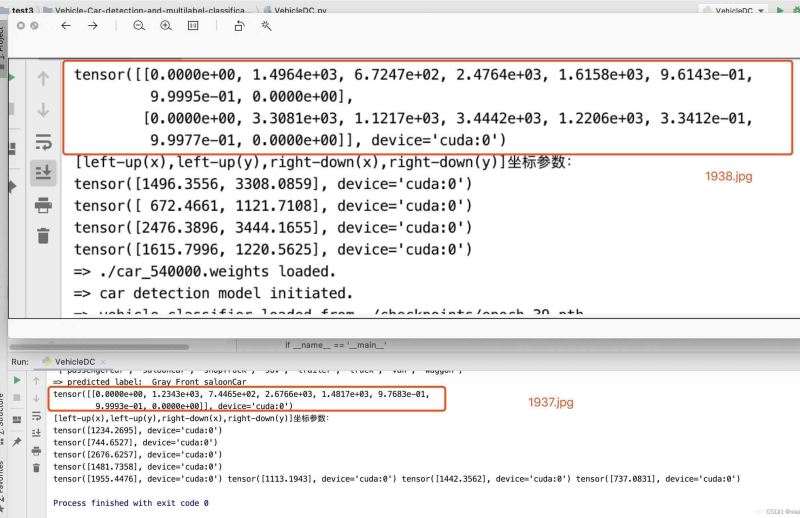获取tensor()数据类型的值
一、问题

只想要216.8973那个数。
二、解决方法
1、单个tensor
tensor.item()
就可以得到216.8973。
2、多个tensor
tensor.tolist()

完美解决~
tensorflow笔记:tensor数据类型
常见的数据类型载体
listnp.arraytf.tensor-
list: 可以存储不同数据类型,缺点不适合存储较大的数据,如图片 -
np.array: 解决同类型大数据数据的载体,方便数据运算,缺点是在深度学习之前就设计好的,不支持GPU -
tf.tensor:更适合深度学习,支持GPU
Tensor是什么
-
scalar: 1.1 -
vector:[1.1] , [1.1,2.2,……] -
matrix:[[1,2,3,],[4,5,6],[7,8,9]] -
torsor:rank > 2 (一般指的是维度大于2的数据)
但是,在tensorflow里面我们把数据的数据都叫tensor
Tensor支持的类型
-
int,float,double boolstring
创建不同类型的Tensor
import tensorflow as tf
# 创建一个整型的数据
tf.constant(1)
# Out[3]: <tf.Tensor: shape=(), dtype=int32, numpy=1>
# 注意因为这里的constant就是一个普通的tensor,不要理解为常量了(TF1.0是代表一个常量)
# 创建一个浮点类型的数据
tf.constant(1.)
# Out[4]: <tf.Tensor: shape=(), dtype=float32, numpy=1.0>
# 若给定一个浮点型的数据,但是指定为int类型会报错
tf.constant(2.2,dtype=tf.int32)
# TypeError: Cannot convert 2.2 to EagerTensor of dtype int32
# 给一数指定双精度
tf.constant(2.,dtype=tf.double)
# Out[6]: <tf.Tensor: shape=(), dtype=float64, numpy=2.0>
# 创建bool类型的数据
tf.constant([True,False])
# Out[7]: <tf.Tensor: shape=(2,), dtype=bool, numpy=array([ True, False])>
# 创建字符串型数据(很少用)
tf.constant("hello,world")
# Out[8]: <tf.Tensor: shape=(), dtype=string, numpy=b'hello,world'>
Tensor Property
下面开始介绍Tensor常用的属性
tf.device
import tensorflow as tf
with tf.device("cpu"):
a = tf.constant([1])
with tf.device("gpu"):
b = tf.range(6)
print(a.device)
print(b.device)
# 数据在CPU和GPU上的转换
aa = a.gpu()
print(aa.device)
bb = b.cpu()
print(bb.device)输出结果:
/job:localhost/replica:0/task:0/device:CPU:0
/job:localhost/replica:0/task:0/device:GPU:0
/job:localhost/replica:0/task:0/device:GPU:0
/job:localhost/replica:0/task:0/device:CPU:0
转换为numpy
c = tf.range(10) #Out[14]: <tf.Tensor: shape=(10,), dtype=int32, numpy=array([0, 1, 2, 3, 4, 5, 6, 7, 8, 9])> c.numpy() #Out[15]: array([0, 1, 2, 3, 4, 5, 6, 7, 8, 9])
Tensor的维度与形状
d = tf.range(10) d.shape # Out[17]: TensorShape([10]) d.ndim # Out[18]: 1 # 用rank查看tensor的维度(秩):返回的是一个tensor类型的数据 tf.rank(d) # Out[19]: <tf.Tensor: shape=(), dtype=int32, numpy=1> tf.rank(tf.ones([3,4,2])) # Out[20]: <tf.Tensor: shape=(), dtype=int32, numpy=3> # tf.name # 是Tensorflow1.0中的概念,现在基本已经淘汰了
python中判断一个数据是不是Tensor
import numpy as np
import tensorflow as tf
a = tf.constant(1.)
b = tf.constant([True,False])
c = tf.constant("hello,world")
d = np.arange(4)
isinstance(a,tf.Tensor)
# Out[27]: True
tf.is_tensor(b)
# Out[28]: True
tf.is_tensor(d)
# Out[29]: False
a.dtype,b.dtype,c.dtype,d.dtype
# Out[32]: (tf.float32, tf.bool, tf.string, dtype('int32'))
a.dtype == tf.float32
Out[33]: True
c.dtype == tf.string
Out[34]: True数据类型的转换
a = np.arange(5)
a.dtype
Out[36]: dtype('int32')
aa = tf.convert_to_tensor(a) # numpy数据转化方法为.astype(np.int64)
# Out[38]: <tf.Tensor: shape=(5,), dtype=int32, numpy=array([0, 1, 2, 3, 4])>
aa = tf.convert_to_tensor(a, dtype=tf.float32)
# Out[40]: <tf.Tensor: shape=(5,), dtype=float32, numpy=array([0., 1., 2., 3., 4.], dtype=float32)>
# 用头tf.cast()数据转化
tf.cast(aa,dtype = tf.float32)
# Out[41]: <tf.Tensor: shape=(5,), dtype=float32, numpy=array([0., 1., 2., 3., 4.], dtype=float32)>
aaa = tf.cast(aa,dtype=tf.double)
# Out[43]: <tf.Tensor: shape=(5,), dtype=float64, numpy=array([0., 1., 2., 3., 4.])>
tf.cast(aaa,dtype=tf.int32)
# Out[44]: <tf.Tensor: shape=(5,), dtype=int32, numpy=array([0, 1, 2, 3, 4])>
# bool 与 int 的转化
b = tf.constant([0,1])
tf.cast(b,tf.bool)
# Out[46]: <tf.Tensor: shape=(2,), dtype=bool, numpy=array([False, True])>
bb = tf.cast(b,dtype=tf.bool)
tf.cast(bb,tf.int32)
# Out[48]: <tf.Tensor: shape=(2,), dtype=int32, numpy=array([0, 1])>tf.Variable
tf.Variable在tensorflow中相比tf.constan一样也是Tensor,tf.Variable特指Tensorflow中哪些可以优化的参数,比如自动求导。
tf.Variable可以理解为是专门为神经网络所设立的一个类型。
a = tf.range(5) b = tf.Variable(a) # Out[51]: <tf.Variable 'Variable:0' shape=(5,) dtype=int32, numpy=array([0, 1, 2, 3, 4])> b.dtype # Out[52]: tf.int32 b.name # Out[53]: 'Variable:0' b = tf.Variable(a, name = "input_data") b.name # Out[55]: 'input_data:0' b.trainable # Out[56]: True isinstance(b,tf.Tensor) # Out[57]: False isinstance(b,tf.Variable) # Out[58]: True tf.is_tensor(b) # Out[59]: True b.numpy() # Out[60]: array([0, 1, 2, 3, 4])
将Tensor类型转化为python中的数据类型
a = tf.ones([]) # Out[63]: <tf.Tensor: shape=(), dtype=float32, numpy=1.0> a.numpy() # Out[64]: 1.0 int(a) # Out[65]: 1 float(a) # Out[66]: 1.0
以上为个人经验,希望能给大家一个参考,也希望大家多多支持Devmax。